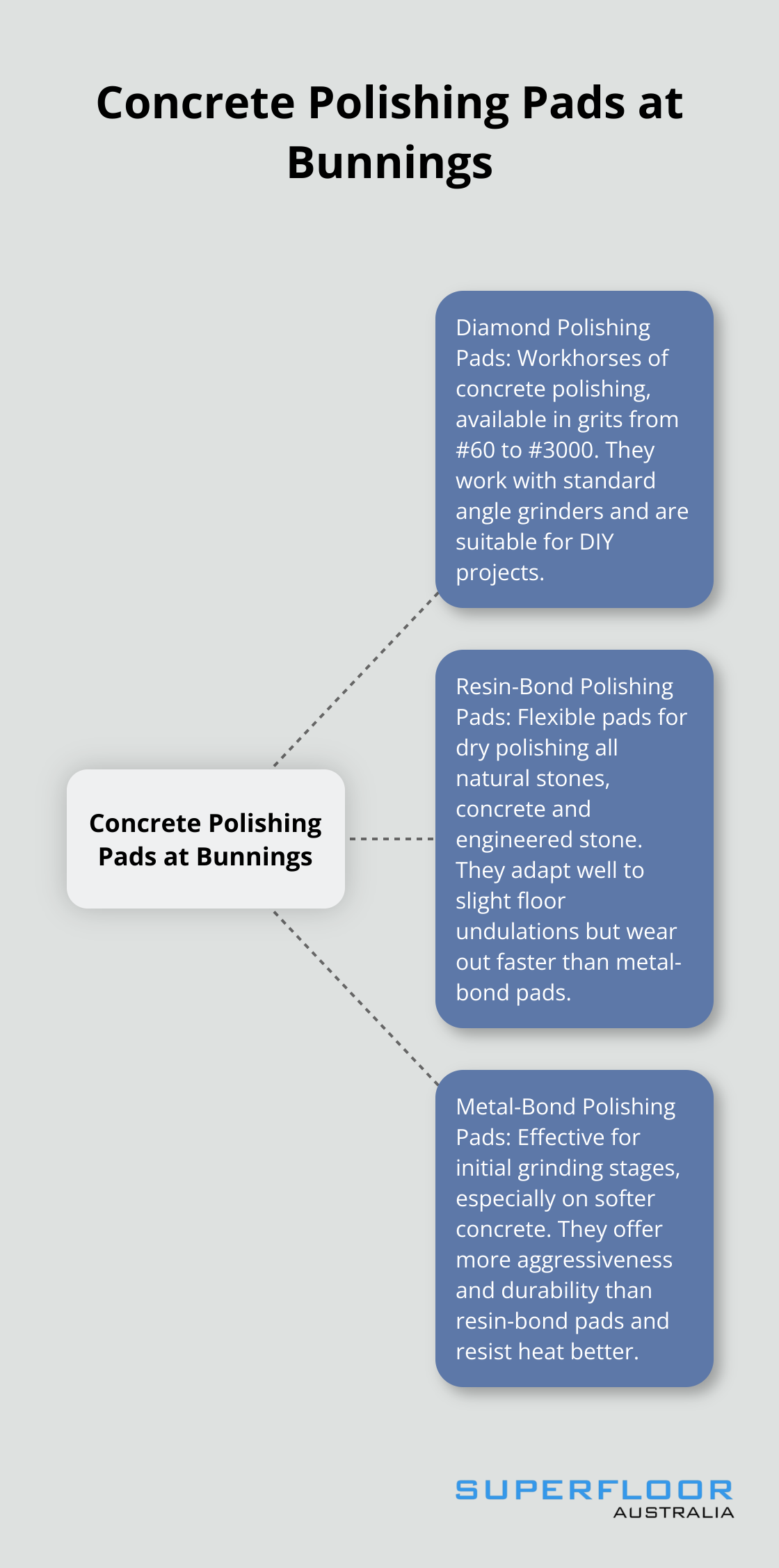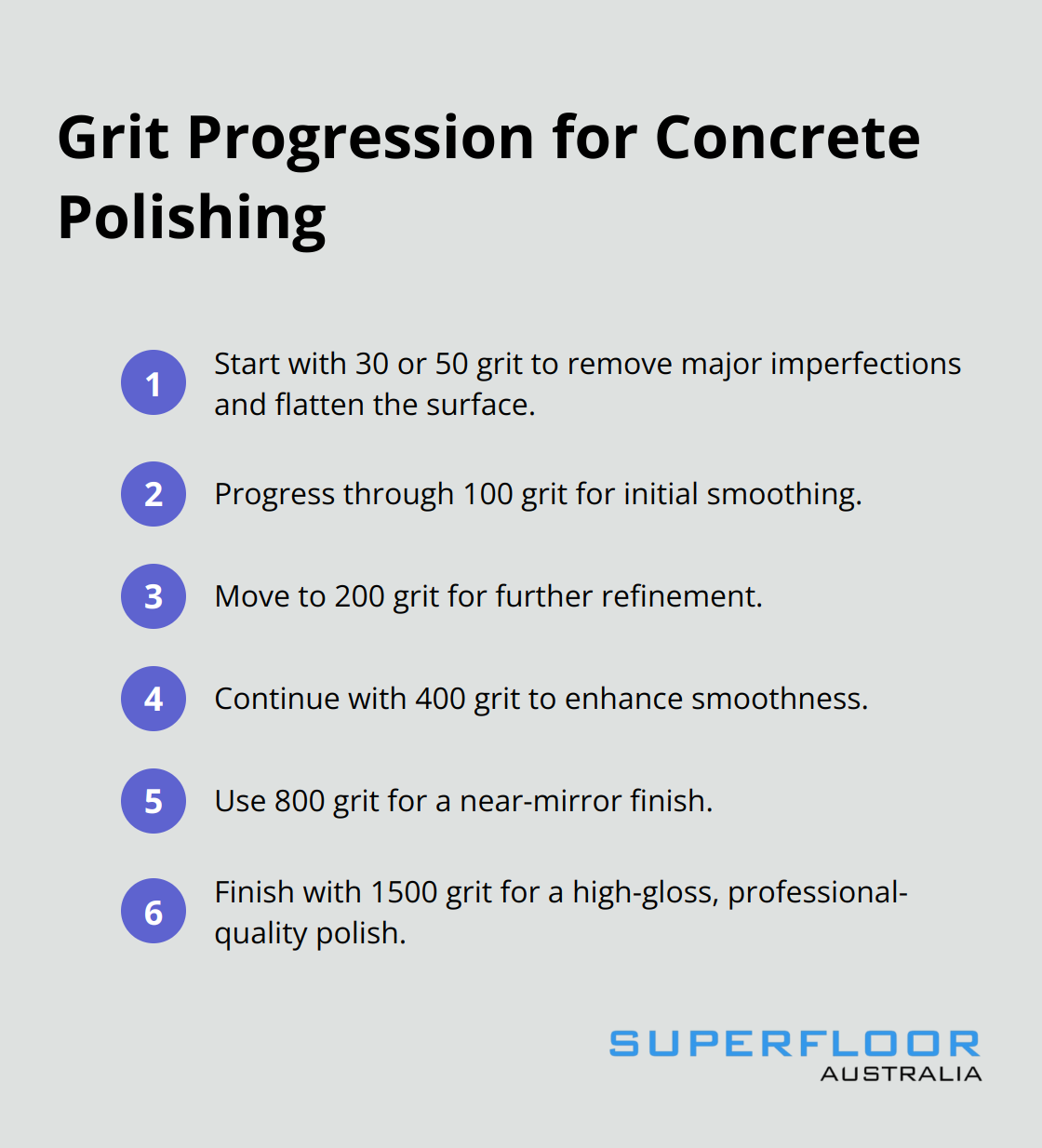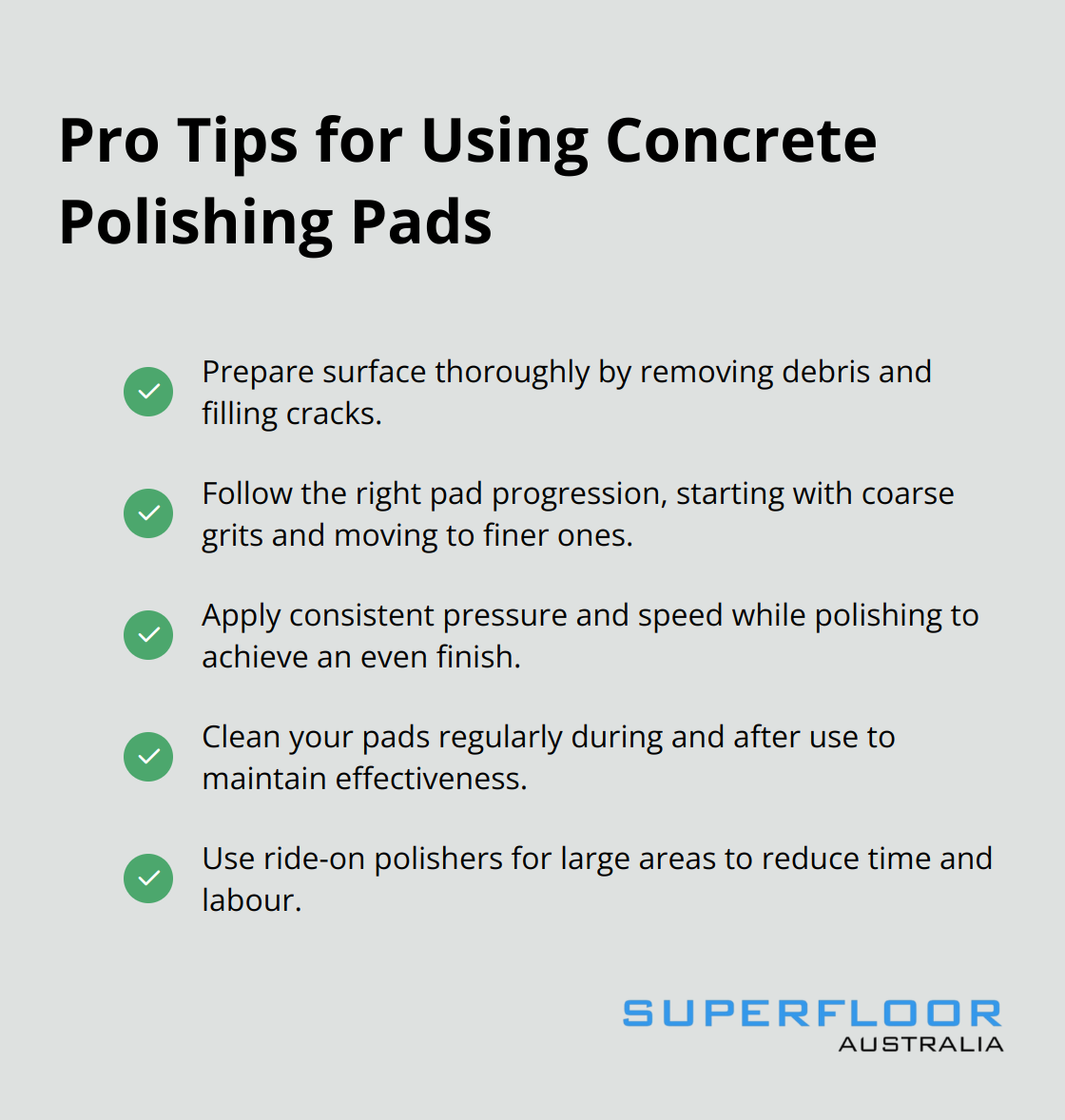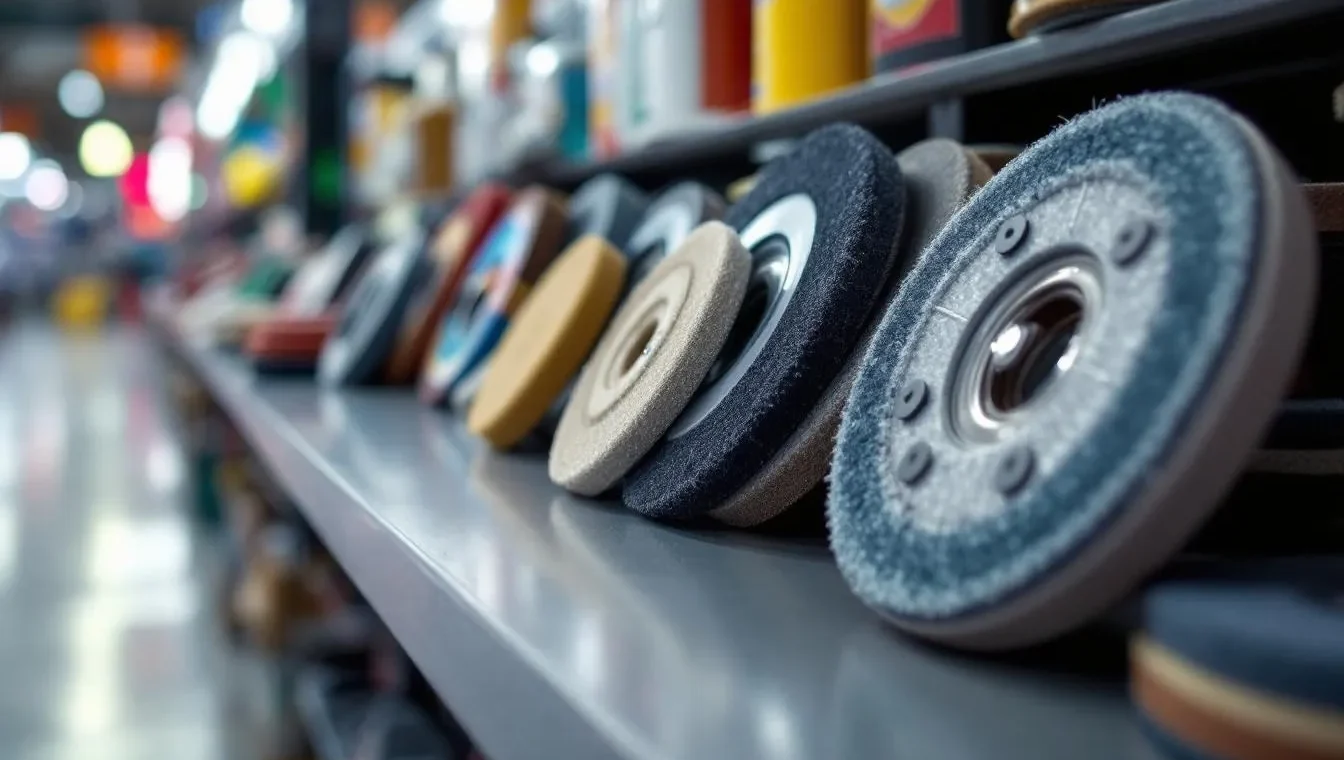At Superfloor Australia, we understand the importance of choosing the right concrete polishing pads for your project.
Bunnings offers a variety of options, but selecting the best one can be challenging.
This guide will help you navigate the world of concrete polishing pads at Bunnings, ensuring you make an informed decision for your specific needs.

What Concrete Polishing Pads Does Bunnings Offer?
At Bunnings, you’ll find a range of concrete polishing pads to suit different project needs. Superfloor Australia has extensive experience with these products, and we’re here to guide you through the options.
Diamond Polishing Pads
Diamond polishing pads are the workhorses of concrete polishing. Swiflex CX ECO diamond sandpaper is available from #60 to #3000 grit. These can give a reasonable polished result on concrete when used with an angle grinder.
Bunnings stocks diamond pads from brands like Diablo and Norton. These pads work with standard angle grinders, making them accessible for DIY enthusiasts. However, for professional-grade results, we recommend using them with specialised concrete polishing machines.
Resin-Bond Polishing Pads
Resin polishing discs are flexible pads for dry polishing all natural stones, concrete and engineered stone. They are long lasting and fast working.
These pads perform particularly well on harder concrete surfaces. They adapt better to slight floor undulations, resulting in a more even polish. However, they wear out faster than metal-bond pads (a factor to consider in your project budget).
Metal-Bond Polishing Pads
For initial grinding stages, especially on softer concrete, metal-bond pads prove most effective. They offer more aggressiveness and durability than resin-bond pads. The “Grind and Seal” process uses a relatively coarse metal-bonded diamond pad for Concrete Grinding, then seals the concrete with a chemical.
These pads remove deep scratches, level uneven surfaces, and expose aggregate in decorative concrete floors. They also resist heat better, which matters when working on large areas or with high-speed polishers.
The key to achieving a professional-quality polished concrete floor lies in using the right progression of pads. Start with the coarsest grit necessary to level the floor and remove existing coatings. Then, work your way up through progressively finer grits until you achieve the desired level of shine.
While Bunnings offers a decent selection for DIY projects, commercial or high-end residential projects require professional-grade equipment and pads to ensure the best possible results. The optimal pad sequence applies for each unique concrete surface.
Now that we’ve covered the types of pads available at Bunnings, let’s explore the factors you should consider when choosing the right pads for your project.
How to Choose the Right Polishing Pads
Selecting the ideal polishing pads for your concrete project is essential for achieving professional results. We’ll share our insights to help you make the best choice.
Grit Size Matters
The grit size of your polishing pads determines the level of abrasiveness and the final finish. For most concrete floors, you should:
- Start with a 30 or 50 grit pad to remove major imperfections and flatten the surface.
- Progress through 100, 200, 400, 800, and 1500 grits for a high-gloss finish.
Each step refines the surface further. Don’t skip grits or you’ll compromise the final result.

Material and Durability Considerations
Resin-bond pads are flexible and work well for final polishing stages, especially on harder concrete. They provide many benefits, including a fast buffing speed, superior durability, and resistance to slipping. However, they wear faster than metal-bond pads.
Metal-bond pads are more durable and aggressive, making them ideal for initial grinding on softer concrete. They’re also heat-resistant (a crucial factor for large area polishing).
Machine Compatibility
Your chosen pads must be compatible with your polishing machine. Most pads at Bunnings are designed for standard angle grinders (fine for small DIY projects). However, for larger areas or professional results, you’ll need pads that fit specialised concrete polishing machines. Ride-on machines dominate large-scale projects, covering more ground quickly and reducing operator fatigue.
Concrete Surface Type
The type of concrete surface you’re working with will influence your pad choice:
- Soft concrete: Use metal-bond pads for initial grinding to prevent excessive wear.
- Hard concrete: Resin-bond pads work well throughout the process.
- Heavily damaged surfaces: Start with more aggressive (lower grit) pads to address deep scratches or unevenness.
Budget Considerations
While it might be tempting to opt for cheaper pads, investing in quality tools often pays off in the long run. Higher-quality pads (often containing better industrial diamonds) can improve cutting efficiency and last longer, potentially reducing your overall project costs.
Bunnings offers a decent selection for DIY enthusiasts, but professional-grade equipment often yields superior results, especially for commercial or high-end residential projects. The scale and importance of your project should guide your tool and material selection. Next, we’ll explore best practices for using these concrete polishing pads to achieve optimal results.
How to Use Concrete Polishing Pads Like a Pro
Prepare Your Surface Thoroughly
Before you polish, make your concrete surface spotless. Remove all debris, dust, and loose particles. Fill cracks or holes with a suitable concrete patching compound. Let it cure completely before you start. This step is essential – if you skip it, you’ll get poor results and might damage your pads.

For older concrete floors, use a chemical stripper to remove existing sealers or coatings. These can interfere with polishing and cause uneven results. Always wear proper personal protective equipment (PPE) when you handle chemicals.
Follow the Right Pad Progression
Start with the coarsest grit needed to level your floor and remove imperfections. Concrete polishing starts with a relatively coarse, Metal-bonded diamond and finishes with finer grits. Progress through finer grits, typically doubling the number each time (e.g., 50, 100, 200, 400, 800, 1500).
Don’t skip any grit level. You might want to save time, but you’ll end up with a less refined finish and possibly visible scratches. Each grit should erase the scratches left by the previous one.
Apply Consistent Pressure and Speed
Consistency is vital when you polish concrete. Use even pressure across the pad and keep a steady speed. If you move too quickly, you’ll get an uneven finish. If you go too slow, you might overheat the pad and damage the concrete.
For large areas, use a ride-on polisher. These machines significantly reduce the time and labour required for concrete finishing compared to manual methods. They work particularly well for commercial or industrial projects.
Clean Your Pads Regularly
Clean your pads often during use. Debris buildup can reduce effectiveness and potentially scratch your surface. For dry polishing, use compressed air to clean the pad. For wet polishing, rinse the pad thoroughly with water.
After each use, clean your pads completely. Soak them in a mix of water and mild detergent, then rinse well. Let them air dry fully before storage. This simple maintenance routine can greatly extend your pads’ life and ensure consistent performance.
While Bunnings offers a decent selection of pads for DIY enthusiasts, professional-grade equipment (like those used by Superfloor Australia) often yields superior results, especially for larger or more demanding projects. Don’t hesitate to invest in quality tools – they’ll pay off through better performance and longevity.
Final Thoughts
Selecting the right concrete polishing pads at Bunnings is essential for a professional-quality polished concrete floor. We’ve explored various types of pads, each suited for different polishing stages. Quality tools lead to better performance and can save costs in the long run (especially for larger projects).
Concrete polishing requires skill and experience to master. For challenging projects or to ensure the best outcome, it’s wise to consult experts. We at Superfloor Australia specialise in delivering high-quality polished concrete flooring in Brisbane.
Our expertise in concrete polishing and honing can help you achieve a sleek, durable, and low-maintenance floor. Whether you’re a DIY enthusiast or a property owner, understanding your options and best practices is key to transforming concrete surfaces into stunning, long-lasting floors.
